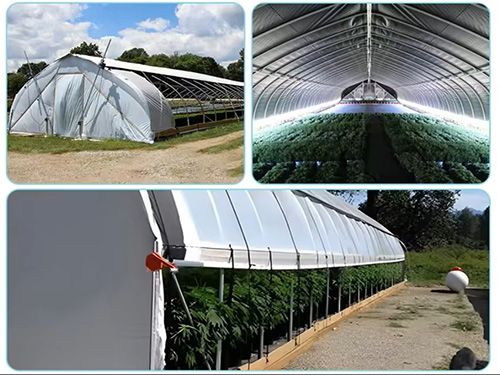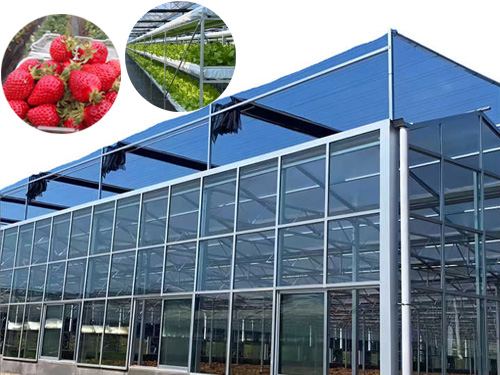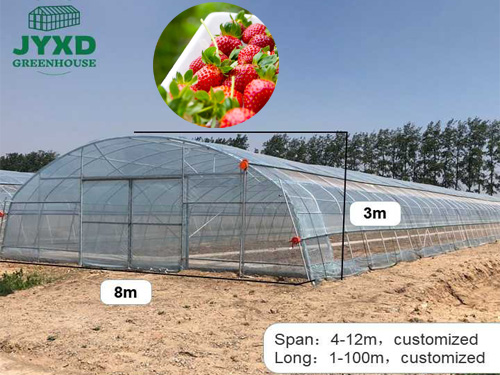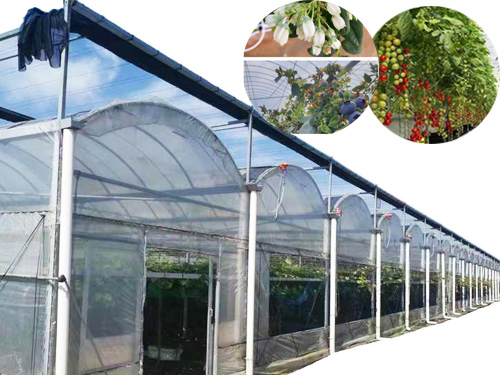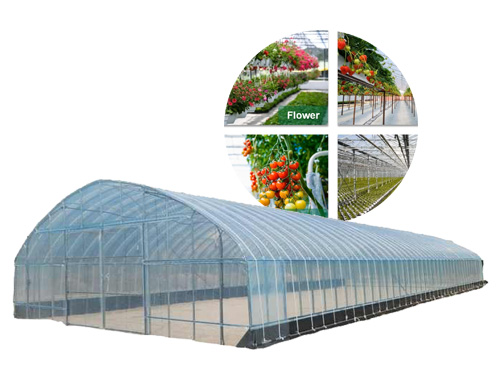NEWS DETAILS
NEWS INFORMATION
How to Combat Greenhouse Soil Degradation: Best Practices for Soil Improvement
AUTHOR:jyxd-greenhouse DATE:2025-01-28 04:41:24 HITS:86
Soil degradation is one of the most pressing challenges faced by greenhouse growers. Over time, soil in greenhouses can lose its fertility, structure, and nutrient balance due to factors such as over-cultivation, poor irrigation practices, and inadequate soil management. Degraded soil leads to reduced crop yields, poor plant health, and increased costs. However, with the right soil improvement practices, you can restore soil quality, boost productivity, and ensure sustainable farming. In this article, we will explore effective strategies to combat greenhouse soil degradation and improve soil health.
Understanding Soil Degradation in Greenhouses
Soil degradation occurs when the natural functions of the soil are compromised, resulting in a loss of its ability to support healthy plant growth. In greenhouses, this can happen rapidly due to the confined nature of the environment and the high intensity of cultivation. The main factors contributing to soil degradation include:
· Nutrient depletion: Continuous crop cultivation without replenishing soil nutrients leads to nutrient imbalance.
· Soil compaction: Heavy watering or frequent foot traffic can compact the soil, reducing air and water flow to plant roots.
· pH imbalances: Improper pH levels can hinder nutrient availability, affecting plant growth.
· Erosion and leaching: Excessive irrigation can wash away important nutrients from the soil.
Addressing these issues requires a multifaceted approach focused on improving soil structure, replenishing nutrients, and maintaining a balanced ecosystem in the soil.
Best Practices for Combating Greenhouse Soil Degradation
To combat soil degradation in greenhouses effectively, it is essential to implement practices that rejuvenate the soil, improve nutrient availability, and support long-term soil health. Below are the best practices to consider:
1. Incorporating Organic Matter
One of the most effective ways to improve soil quality in greenhouses is by adding organic matter. Organic matter, such as compost, manure, and cover crops, helps restore the structure, fertility, and microbial activity in the soil.
· Compost: Adding well-decomposed compost to the soil improves its texture, water retention, and nutrient content. It also supports beneficial microbes that break down organic materials into usable nutrients for plants.
· Manure: Animal manure, when properly composted, provides a rich source of nitrogen, phosphorus, and potassium—key nutrients for plant growth.
· Cover Crops: Growing cover crops like legumes during the off-season can enrich the soil by fixing nitrogen, improving soil structure, and preventing erosion.
By regularly replenishing the soil with organic matter, you can counteract the effects of soil degradation and foster a healthy growing environment.
2. Crop Rotation and Polyculture
Implementing crop rotation and polyculture (growing multiple types of crops together) in the greenhouse can help reduce soil degradation by maintaining nutrient balance and preventing soil-borne diseases.
· Crop Rotation: Rotating crops ensures that the same nutrients are not depleted year after year. For example, legumes, which fix nitrogen in the soil, can be rotated with crops that require high nitrogen levels, such as leafy greens.
· Polyculture: Growing a variety of crops together in the same space can reduce the risk of pest infestations, encourage biodiversity, and maintain soil health by reducing the demands placed on the soil by any one plant species.
These practices can help restore nutrients, improve soil structure, and reduce the impact of monocropping on soil degradation.
3. Avoiding Over-Irrigation and Implementing Drip Irrigation
Excessive watering is one of the primary causes of soil degradation in greenhouses. Over-irrigation can lead to nutrient leaching, waterlogging, and soil erosion. To combat this, it is essential to adopt efficient irrigation systems and practices that deliver water precisely where it is needed.
· Drip Irrigation: Drip irrigation delivers water directly to the roots of plants, minimizing water waste and reducing the risk of over-watering. This system helps maintain optimal soil moisture levels while preventing waterlogging and nutrient leaching.
· Soil Moisture Monitoring: Use soil moisture sensors to monitor the moisture levels in the soil and ensure that irrigation is applied only when necessary.
By optimizing water usage, you can preserve soil nutrients, improve root health, and prevent the negative effects of over-irrigation.
4. Amending Soil pH
Soil pH plays a crucial role in nutrient availability and plant health. If the pH of the soil becomes too acidic or too alkaline, it can lead to nutrient imbalances, making it difficult for plants to absorb essential nutrients.
· Regular Soil Testing: Regularly test your soil’s pH to identify any imbalances. A pH level between 6.0 and 7.0 is ideal for most greenhouse crops.
· Lime for Acidic Soil: If your soil is too acidic, adding agricultural lime can help raise the pH and improve nutrient availability.
· Sulfur for Alkaline Soil: If the soil is too alkaline, elemental sulfur can be added to lower the pH and restore balance.
Properly managing soil pH will help enhance nutrient uptake, improve plant health, and prevent further soil degradation.
5. Minimizing Soil Compaction
Soil compaction occurs when soil particles are pressed together, reducing the amount of air and water that can reach plant roots. In greenhouses, soil compaction is often caused by excessive watering, heavy equipment, or constant foot traffic.
· Aeration: Regularly aerating the soil, either manually or using specialized equipment, helps break up compacted layers and allows air and water to reach the roots more easily.
· Raised Beds and Containers: Growing plants in raised beds or containers can help avoid compaction in the soil. These methods provide better drainage and reduce the need for foot traffic in the growing area.
By preventing soil compaction, you can maintain proper root development, improve water retention, and enhance soil structure.
6. Using Biochar and Other Soil Amendments
Biochar is a highly effective soil amendment that can help combat soil degradation in greenhouses. This carbon-rich material, derived from plant matter, improves soil fertility, water retention, and microbial activity.
· Improved Soil Structure: Biochar enhances soil structure by improving aeration and water retention, particularly in sandy or clay-heavy soils.
· Nutrient Retention: Biochar helps retain nutrients in the soil by binding to them and preventing leaching, ensuring that plants have access to a steady supply of essential minerals.
· Increased Microbial Activity: Biochar provides a habitat for beneficial microorganisms that break down organic matter and enhance nutrient cycling.
Incorporating biochar into your soil can help restore fertility, improve soil health, and combat degradation in the long term.
Monitoring and Adjusting Soil Health
To effectively combat soil degradation, it is important to continuously monitor and adjust soil conditions. Regular soil testing, moisture monitoring, and observation of plant health will provide valuable insights into the effectiveness of your soil improvement practices.
· Soil Testing: Conduct soil tests periodically to monitor nutrient levels, pH, and organic matter content. This will help you identify any deficiencies and make necessary adjustments.
· Plant Health: Pay attention to the overall health of your plants. Signs of nutrient deficiency, stunted growth, or poor yields may indicate issues with soil fertility that need to be addressed.
By staying proactive and continuously improving soil conditions, you can prevent soil degradation and ensure long-term success in your greenhouse.
Conclusion
Soil degradation in greenhouses can significantly impact crop yields and plant health. However, by implementing the best practices outlined in this article, including adding organic matter, practicing crop rotation, optimizing irrigation, and managing soil pH, you can combat soil degradation and restore soil fertility. With consistent monitoring and proper soil management, you can create a thriving, sustainable greenhouse environment that supports healthy plants and maximizes productivity.
Hebei Juyou Xinda Greenhouse Facilities Co.,Ltd.
Copyright © 2024-2025 https://www.jyxd-greenhouse.com. All Rights Reserved Hebei Juyou Xinda Greenhouse Facilities Co.,Ltd.Copyright





 Current Location:
Current Location:


